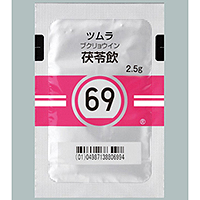- :
- Unit Price:
- Quantity:


-
Code:005411-001
- Tsumura Bukuryouin [69] : 189 sachets
- $310.00
Up to 1 pieces per person
10% discount for total amount over $100
shipping schedule : 5 to 10 working days after payment
warehouse:Japan1
Manufacturer :TSUMURA & CO.
Brand :TSUMURA & CO.
JAN Code:4987138806932
-
Description
-
TSUMURA Bukuryoin Extract Granules (hereafter TJ-69) is indicated for the relief of the following symptoms of those patients with nausea or heartburn and decreased urine volume:Gastritis, gastric atony, and excessive fluid retention in the stomach
-
Presentation
-
189 sachets
-
Feature
-
light grayish brown granules
-
Active Ingredients
-
7.5g(3sachets for 1day): TSUMURA Bukuryoin extract granules contains 2.75 g of a dried extract of the following mixed crude drugs.JP Poria Sclerotium 5.0 gJP Atractylodes Lancea Rhizome 4.0 gJP Citrus Unshiu Peel 3.0 gJP Ginseng 3.0 gJP Immature Orange 1.5 gJP Ginger 1.0 g(JP: The Japanese Pharmacopoeia)
-
Effect/Efficacy
-
TSUMURA Bukuryoin Extract Granules (hereafter TJ-69) is indicated for the relief of the following symptoms of those patients with nausea or heartburn and decreased urine volume:Gastritis, gastric atony, and excessive fluid retention in the stomach
-
Usage/Dosage
-
The usual adult dose is 7.5 g/day orally in 2 or 3 divided doses before or between meals. The dosage may be adjusted according to the patient's age and body weight, and symptoms
-
Cautions
-
(1)When TJ-69 is used, the patient's“SHO” (constitution/symptoms) should be taken into account. The patient’s progress should be carefully monitored, and if no improvement in symptoms/findings is observed, continuous treatment should be avoided.
2)When TJ-69 is co-administered with other Kampo-preparations (Japanese traditional herbal medicines), etc., attention should be paid to the duplication of the contained crude drugs.
-
Contraindication
-
TJ-69 has not been investigated (drug use investigations, etc.) to determine the incidence of adverse reactions. Therefore, the incidence of adverse reactions is not known.